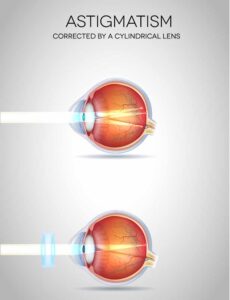Astigmatism is a type of ametropia. The term ametropia means that due to abnormalities within the refractive structures of the eye or due to an abnormal size and/or shape of the eye, light rays from a distant object cannot be focused onto the part of the retina (the innermost, light-sensing layer of the eye) which forms the clearest image (the fovea centralis).
In astigmatic individuals, when the crystalline lens is relaxed (I.e. there is no accomodation), light rays from a distant object are refracted in such a way that they are focused on 2 different points. These 2 points may be in front of, behind, or on the retina. In cases of compound astigmatism, these 2 points may be a combination of any of the locations listed above. This phenomenon causes individuals suffering from astigmatism to be unable to make out clear outlines of different objects. Astigmatism may occur due to:
- Changes in the curvature of the cornea because of developmental anomalies or due to different disease processes which may have occurred later on in life.
- Changes in the refractive index of the crystalline lens may occur due to opacification of the lens matter
- Displacement of the lens from its original position such that it would cause light to be focused on different points on the retina.
Astigmatism Sign & Symptoms:
The main complaints of astigmatic individuals include:
- Blurring of vision
- Squinting of the eyes in order to make outlines of different objects sharper
- Eye Strain (Asthenopic) symptoms are experienced due to exhaustion of the eye produced by sustenance of the accommodative reflex. These include:
- Headache
- Watering of the eyes
- Tiredness of the eyes
- Photophobia (bright light hurts the eyes)


Evaluation of disease:
To confirm the diagnosis, your doctor may ask you to read alphabets/signs placed at a certain distance. Your eyes may also be examined using different apparatus. An ultrasound test, or a test to chart the curvature of your cornea may also be ordered.


Treatment:
Treatment of hyperopia may be conservative or surgical.
- Conservative (optical) therapy options are preferred for individuals less than the age of 25. This is because after the age of 25, the eyeball stops growing and the refractive error stabilises. Conservative therapies include the use of:
- Spectacles which have:
- Spherocylindrical lenses
- Cylindrical lenses
- Hard contact lenses
- Spectacles which have:
- Surgical therapies: Your doctor is best equipped to decide whether or not surgery will correct your hyperopia. Surgical correction of astigmatism may be done by performing surgery on the cornea or by replacing the crystalline lens.
Important points to know:
Generally, astigmatism has been established as a treatable condition. However, prevention is always better than cure. To prevent the development of astigmatism it is thus imperative that any preexisting conditions be evaluated by a physician and treated if necessary. This is the only way through which disease processes can be stopped from wreaking havoc on the refractive media of the eye.
As always, we would like to reiterate that proper eye care and follow-up is essential to promote eye health.
References:
Woltsche, N., Werkl, P., Posch-Pertl, L., Ardjomand, N., & Frings, A. (2019). Astigmatismus [Astigmatism]. Der Ophthalmologe : Zeitschrift der Deutschen Ophthalmologischen Gesellschaft, 116(3), 293–304. https://doi.org/10.1007/s00347-019-0865-7
Schiefer, U., Kraus, C., Baumbach, P., Ungewiß, J., & Michels, R. (2016). Refractive errors. Deutsches Arzteblatt international, 113(41), 693–702. https://doi.org/10.3238/arztebl.2016.0693
Disclaimer: The information on this blog is intended to educate and inform and is not a substitute for medical advice, diagnosis or treatment. Prior to acting on the information provided on this blog, you should consult your doctor/healthcare professional.
